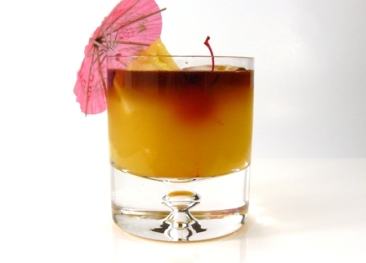It’s Thirsty Thursday everyone!! That means the weekend is right around the corner. Get through the next few days by sipping on our featured drink of the week the Mai Tai. One thing this drink does is put you in the mood for a tropical vacation. Some of the best Mai Tai’s I’ve ever had were in the Bahamas and every time I sip one it brings me back to paradise. Let learn a little bit about this vacation style beverage.
thing this drink does is put you in the mood for a tropical vacation. Some of the best Mai Tai’s I’ve ever had were in the Bahamas and every time I sip one it brings me back to paradise. Let learn a little bit about this vacation style beverage.
A Mai Tai is made with white rum, dark rum, orange curaçao, Orgeat syrup and lime juice. They are typically garnished with a pineapple or a tropical flower. Shake your drink with ice and pour over ice for a refreshing cocktail that will transport you and your tastebuds to white sand beaches and crystal clear skies.
 The Mai Tai is claimed to be invented by two rival restaurants in L.A. Trader Vic’s owned by Victor Bergeron claimed to have made the drink in 1944. Vic had friends visiting from Tahiti so he created this cocktail. One of the friends yelled out “very good” in Tahitian, which in the native tongue translates to Mai Tai. The rival restaurant who stakes their claim to fame is Don the Beachcomber restaurant. This tinsel town eatery claimed to have invented the drink in 1933, 11 years before Vic and his Tahitian friends. Reports claim that the Mai Tai’s from both restaurants taste so different that you may not even know they are the same drink. Officially there are 11 different ways to make a Mai Tai, so the argument will still persist.
The Mai Tai is claimed to be invented by two rival restaurants in L.A. Trader Vic’s owned by Victor Bergeron claimed to have made the drink in 1944. Vic had friends visiting from Tahiti so he created this cocktail. One of the friends yelled out “very good” in Tahitian, which in the native tongue translates to Mai Tai. The rival restaurant who stakes their claim to fame is Don the Beachcomber restaurant. This tinsel town eatery claimed to have invented the drink in 1933, 11 years before Vic and his Tahitian friends. Reports claim that the Mai Tai’s from both restaurants taste so different that you may not even know they are the same drink. Officially there are 11 different ways to make a Mai Tai, so the argument will still persist.
Looking to sip on a Mai Tai poolside? Give us a call 920.236.7777



 Pina Colada is Spanish for strained pineapple, which comes from one the drink’s main ingredients. Other ingredients include white rum and coconut cream. It has been the national drink of Puerto Rico since 1978 and the people of the island celebrate national Pina Colada day every year on July 10th. Like many popular drinks the Pina Colada has a history that is debated and still to this day a definite rivalry. The two main accounts of where the drink was first made come from a dispute between two bartenders. The first, Ramon Marrero Perez, claims to have made the delicious drink first at the Caribe Hilton Hotel’s Beachcomber Bar in San Juan in 1954. Another Ramon tells a different story though; Ramon Portas Mingot says he created the drink in 1963 at the Barrachina Restaurant in Old San Juan. And regardless of which account you believe you can still visit both locations to sample what claims to be the original Pina Colada.
Pina Colada is Spanish for strained pineapple, which comes from one the drink’s main ingredients. Other ingredients include white rum and coconut cream. It has been the national drink of Puerto Rico since 1978 and the people of the island celebrate national Pina Colada day every year on July 10th. Like many popular drinks the Pina Colada has a history that is debated and still to this day a definite rivalry. The two main accounts of where the drink was first made come from a dispute between two bartenders. The first, Ramon Marrero Perez, claims to have made the delicious drink first at the Caribe Hilton Hotel’s Beachcomber Bar in San Juan in 1954. Another Ramon tells a different story though; Ramon Portas Mingot says he created the drink in 1963 at the Barrachina Restaurant in Old San Juan. And regardless of which account you believe you can still visit both locations to sample what claims to be the original Pina Colada.